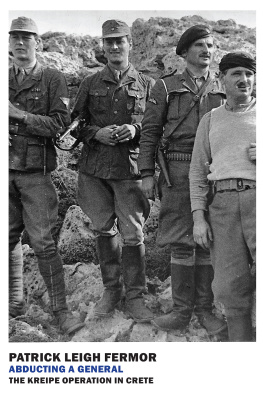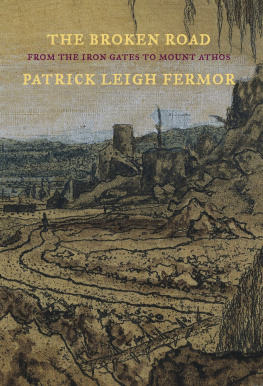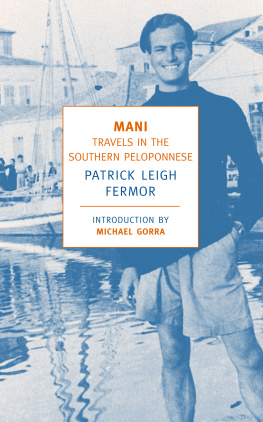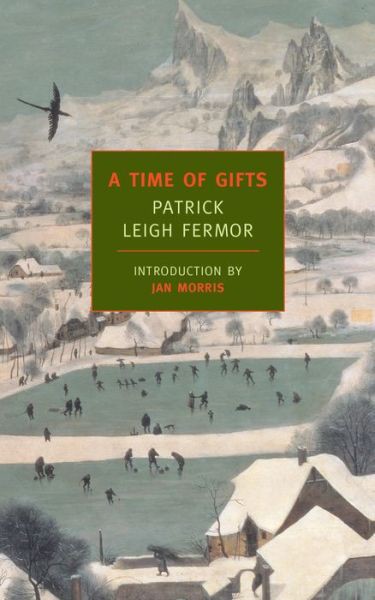PATRICK LEIGH FERMOR was born in 1915 of English and Irish descent. After his stormy schooldays, followed by the walk across Europe to Constantinople that begins in A Time of Gifts (1977) and continues through Between the Woods and the Water (1986), he lived and traveled in the Balkans and the Greek Archipelago. His books Mani (1958) and Roumeli (1966) attest to his deep interest in languages and remote places. In the Second World War he joined the Irish Guards, became a liaison officer in Albania, and fought in Greece and Crete. He was awarded the DSO and OBE. He now lives partly in Greece in the house he designed with his wife Joan in an olive grove in the Mani, and partly in Worcestershire. He was knighted in 2004 for his services to literature and to BritishGreek relations.
JAN MORRIS was born in 1926, is Anglo-Welsh, and lives in Wales. She has written some forty books, including the Pax Britannica trilogy about the British Empire, studies of Wales, Spain, Venice, Oxford, Manhattan, Sydney, Hong Kong, and Trieste, six volumes of collected travel essays, two memoirs, two capricious biographies, and a couple of novelsbut she defines her entire oeuvre as disguised autobiography. She is an honorary D. Litt. of the University of Wales and a Commander of the Order of the British Empire.
A TIME OF GIFTS
On Foot to Constantinople: From the Hook of Holland to the Middle Danube
PATRICK LEIGH FERMOR
Introduction by
JAN MORRIS
NEW YORK REVIEW BOOKS

New York
CONTENTS
INTRODUCTION
E NVY IS the writers sin, as everyone knows, but there can be few writers in the English-speaking world who resent Patrick Leigh Fermors preeminence as one of the great prose stylists of our time. He has no rivals, and so stands beyond envy.
His literary genre is difficult to define. He is generally classified as a travel writer, but he is really infinitely more than that. Certainly he describes the experiences of travel as providing a theme for his literature, but he is also a memoirist, a historian, a connoisseur of art and architecture, a poet, a humorist, a story-teller, a social chronicler, something of a mystic, and one of Gods own adventurers. These varied gifts were first revealed in full glittering ensemble in A Time of Gifts, published in 1977 when he was sixty-two years old.
By then he had lived half an eventful lifetime, and had already published three much-admired books of travel. A born irregular, he had happily abandoned an expensive formal education in his seventeenth year, and joined the British Army at the start of World War II. From the ultra-formal Irish Guards (he is half Irish by descent) he gravitated naturally to guerrilla warfare, his obvious military metier, and in 1942 crowned his career as a licensed ruffian by organizing the abduction of a German general in occupied Crete, and whisking him away to Egypt in a motor launch.
Living in Cretan caves disguised as a shepherd probably came easily enough to Leigh Fermor, and A Time of Gifts tells us why. He was built that way. Nine years before Major Patrick Leigh Fermor, holed up in the Cretan mountains with his accomplices, was making final arrangements to kidnap General Kreipe, the strapping young Paddy Leigh Fermor, fresh from Kings School, Canterbury, was stepping from a steamer at the Hook of Holland preparing to walk across Europe to Constantinople. He saw himself as a Wandering Scholar. He was alone, and he was ready to sleep anywhere, talk to anybody, live on almost nothing, eat or drink anything, have a go at any language, make friends with strangers rich or poor, and brave the worst that heat and cold, mishap and blister, officialdom, prejudice and politics could do to him. What could be better preparation for subversive skullduggery in Crete?
There could be no better material, either, as it turned out long afterwards, for a retrospective book, looking back at pre-war Europe across a darkling plain of history and experience. The young Leigh Fermor had made his trek across the continent at a fateful moment of European history. The 1930s were a remembering time, and a waiting time too. Still alive in the public consciousness was the old Europe, the Europe of the princes and the peasants, of Franz Joseph and Kaiser William, of grand old cities still intact and ancient traditions honored. But intermittently present in the public mind too, if generally suppressed, was the apprehension of catastrophe to come: 1933, the year Leigh Fermor set foot in Germany for the first time in his life, was the year Adolf Hitler came to power.
As Leigh Fermor says himself, at the time he didnt give a damn. It is one of the fascinations of A Time of Gifts that its journey is in effect evoked for us by two people: the carefree young dropout who experienced it, and stored it up in memory and in diary, and the immensely experienced author who, knowing more about history forty years later, turned it into art.
* * *
Being altogether sui generis, A Time of Gifts behaves just as it pleases. It follows no precedent, obeys no conventions. The nearest equivalents I can think of are the works of Ibn Batuta, written over a lifetime six centuries before, or John Ruskins unclassifiable work of memoir, philosophy, and travel, Praeterita. More obvious predecessorsAlexander Kinglakes Eothen or Robert Byrons The Road to Oxianaare different in kind to my mind because they do not reflect, as this book does, at once the maturing of a mind and the condition of a continent. Besides, Leigh Fermor is Leigh Fermor, and neither Kinglake nor Byron kidnapped any generals...
The Cretan adventure of 1942 pervades the narrative of 1933, because it obviously pervaded the mind of the author in 1977. His introductory essay to the book, addressed to his comrade-in-arms Xan Fielding, hints at the wartime coup, and means that it pervades our own minds too. For this is by no means a simple memoir of travel: it is full of allusions, afterthoughts and cross-references, backwards and forwards, in and out, and it is tantalizingly open-endedit finishes halfway to Constantinople, and the reader is left waiting for a later volume to get there.
The form of the book is layered, too. Sometimes it is imaginatively exploited reminiscence, sometimes pure impressionism. Sometimes it contains suggestions of what is to happen later, all unknown to the young traveler. There are virtuoso displays of scholarship and insight beyond the powers of any nineteen-year-old, but there are also reported responses so evidently immediate, so engagingly openhearted, that they could only come from Paddys own notebooks, scribbled in hayrick, drawing room, or hospitable pub en route. Leigh Fermor is not only remembering himself, he is looking at himself too, as in one of those Cubist paintings in which we see profile and front face at the same time.
Nor is there any rigidity to the books construction. It is all fluid. At any moment we are whisked off into another train of thought, another pace, another mood. Just as we never know where we will spend the next night, in a barn, in a schloss, in a strangers spare room or in a police cell, so we never know what sudden flight of learned fancy is going to engage us for the next few pages. Paddys chosen route was not sacrosanct. He thought it at once rational and romantic to walk clear across Europe from the North Sea to the Bosphorus, up the Rhine valley, down the Danube, but when somebody remarked in Bratislava that he really ought to see Prague, instantly off he went for an unplanned detour of several hundred miles (and a complete chapter). And although he originally intended to rough it all the way, by the time he reaches Central Europe we find him, courtesy of hospitable friends or friends of friends, spending comfortable interludes in castles.











